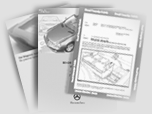| Test step/Test scope |
 |
Test condition |
Nominal value |
Possible cause/Remedy 1) |
1.0
Press CL interior switch |
   |
CL interior switch (S6/1s2):
Press close
Press open |
         
     
   
|
 23 PSE/CL 23 PSE/CL  1.0 1.0 |
2.0
Press RHR unlocking switch |
   |
RHR unlocking switch (S6/1s3):
Pressed
Not pressed |
 
  
|
See
AD80.20-P-6003-01B |
3.0
Left front door switch (S17/3) |
   |
Left front door:
Open
Closed |
 
  
|
 23 PSE 23 PSE  1.0 1.0 |
4.0
Right front door switch (S17/3) |
   |
Right front door:
Open
Closed |
 
  
|
 23 PSE 23 PSE  2.0 2.0 |
5.0
Left rear door switch (S17/5)
(except Model 208) |
   |
Left rear front door:
Open
Closed |
 
  
|
 23 PSE 23 PSE  3.0 3.0 |
6.0
Right rear door switch (S17/5)
(except Model 208) |
   |
Right rear front door:
Open
Closed |
 
  
|
 23 PSE 23 PSE  4.0 4.0 |
7.0
Trunk lamp switch (S17/8)
(Model 202, 208, 210 sedan only)
Tailgate closing assist switch/interior illumination switch (A12s1)
|
   |
Trunk lid/tailgate:
Open
Closed |
 
  
|
 23 PSE 23 PSE  5.0 5.0 |
8.0
Trailer recognition
(not  ) ) |
   |
Trailer recognition microswitch (X58s1):
Connected
Not connected |
 
   |
Wiring,
X58s1 |
9.0
RTR switch (N72s15)
(except Model 202,
210 stationwagen) |
   |
RTR switch (N72s15):
Pressed
Not pressed |
 
   |
See
AD80.20-P-6002-03B |
10.0
Trunk release switch (S15/1)
(except models 202,
210 station wagen) |
   |
Switch located on trunk lid lock
switch (S88/2):
Pressed
Not pressed |
 
   |
 23 PSE 23 PSE  6.0 6.0 |
11.0
Locknut switch 1
(only   ) ) |
   |
Use mechanical key on vehicle to:
Lock vehicle
Release key |
 
   |
See section 4.9,  23, 23,
See DM, B&A, section 5.4,  13 13 |
12.0
Locknut switch 2
(only   ) ) |
   |
Use mechanical key on vehicle to:
Lock vehicle
Release key |
 
   |
See section 4.9,  23, 23,
See DM, B&A, section 5.4,  13 13 |


 Printable version
Printable version


 Printable version
Printable version